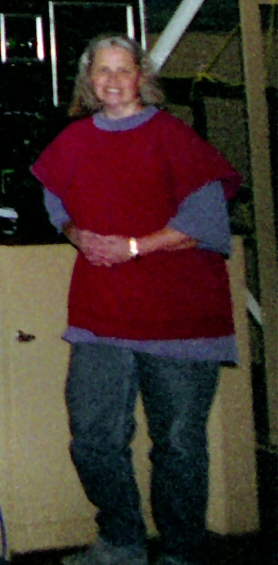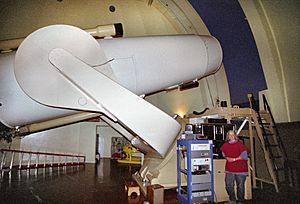Jean Mueller facts for kids
Jean Mueller is an American astronomer born in 1950. She is famous for discovering many comets, minor planets (small rocky objects in space), and a large number of supernovas (exploding stars). She made these amazing discoveries while working at the Palomar Observatory in California, USA.
Contents
Jean Mueller's Career in Astronomy
Becoming a Telescope Operator
In 1983, Jean Mueller made history. She became the first woman to operate the huge Hooker telescope at Mt. Wilson Observatory. Two years later, in 1985, she was also the first woman hired as a telescope operator at Palomar Observatory. A telescope operator helps run the giant telescopes, making sure they point correctly and collect data.
Working on the Palomar Sky Survey
In August 1985, a big project called the Second Palomar Observatory Sky Survey (POSS II) began. This project used the Samuel Oschin telescope (which was then called the 48-inch Schmidt Camera) at Palomar. Jean Mueller joined the team in July 1985 as the 48-Inch Night Assistant.
Her job was to operate the telescope and observe the night sky. She took over 5,500 special photographic glass plates. These plates captured images of the sky. On June 3, 2000, she had the honor of setting the telescope and removing the very last plate from this historic camera. On that same night, she also discovered her last supernova, named 2000cm.
How Discoveries Were Made
Jean Mueller spent many hours of her own time carefully looking at the POSS II plates. She used a special machine that magnified the images on the 1-millimeter thick glass plates. She was searching for comets, fast-moving asteroids, and supernovae.
Sometimes, she would mark over a hundred galaxies on a single plate. Then, she would compare these new plates with older ones from the first Palomar Sky Survey (POSS I). This comparison helped her spot new objects or changes in the sky. All of her discoveries were made during the years she worked on the POSS II project.
Jean Mueller's Discoveries
Jean Mueller is known for finding many different objects in space.
| 4257 Ubasti | August 23, 1987 |
| 4558 Janesick | July 12, 1988 |
| 6569 Ondaatje | June 22, 1993 |
| 9162 Kwiila | July 29, 1987 |
| (11028) 1987 UW | October 18, 1987 |
| 11500 Tomaiyowit | October 28, 1989 |
| 12711 Tukmit | January 19, 1991 |
| 16465 Basilrowe | March 24, 1990 |
| 19204 Joshuatree | June 21, 1992 |
| 24658 Misch | October 18, 1987 |
| (360191) 1988 TA | October 5, 1988 |
| (408752) 1991 TB2 | 3 October 1991 |
| (412976) 1987 WC | 21 November 1987 |
|
|
Comets
While working at Palomar Observatory, Jean Mueller discovered a total of 15 comets. These include 7 periodic comets (which return to our solar system regularly), such as 120P/Mueller and 173P/Mueller. She also found 8 non-periodic comets, which might only pass by once.
Minor Planets
The Minor Planet Center officially credits Jean Mueller with finding 13 numbered minor planets between 1987 and 1993. Some of these are near-Earth objects, meaning they pass close to Earth. Examples include the Apollo asteroids 4257 Ubasti, 9162 Kwiila, and 12711 Tukmit, and the Amor asteroid 6569 Ondaatje.
Supernovae
Jean Mueller also discovered 107 supernovae. Supernovae are powerful and bright explosions of stars. Nine of these discoveries were made with other astronomers.
Honors and Recognition
An asteroid was named in honor of Jean Mueller because of her important astronomical discoveries. This asteroid, called 4031 Mueller, is located in the main asteroid belt. It was found on February 12, 1985, by Carolyn Shoemaker at Palomar Observatory. The official naming of the asteroid was announced on December 12, 1989.
Community Involvement
Jean Mueller is an advisor for the Meade 4M Community. This group supports her work in sharing astronomy with others and reaching out to the public.
See also
 In Spanish: Jean Mueller para niños
In Spanish: Jean Mueller para niños



